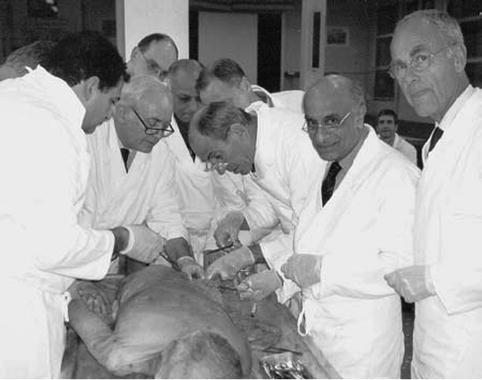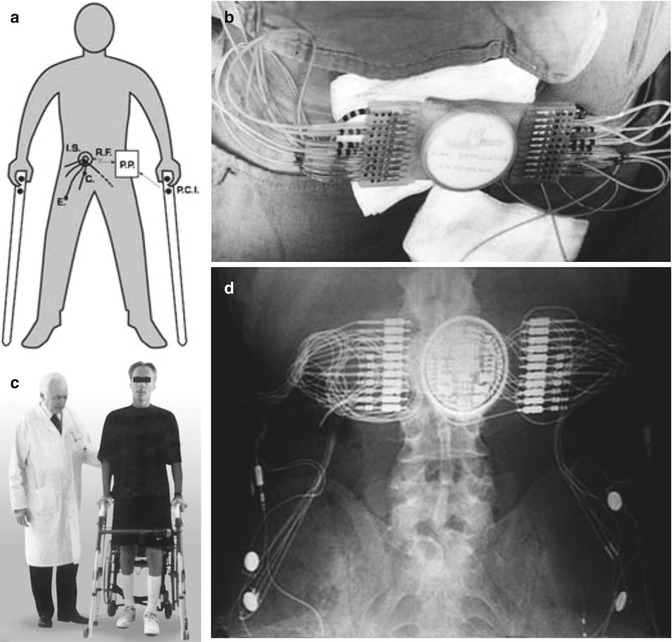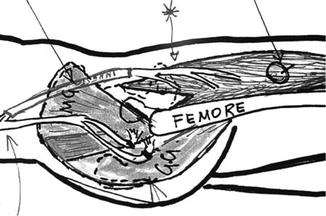Fig. 6.1
“Stand up and walk” (SUAW) international surgical team in front of the Anatomical Institute of the University of Montpelier, 13 December 1998 (from left to right): Giorgio Brunelli (Brescia, Italy), the late Krish Krishnan (Salford, UK), Ole Osgaard (Denmark), Bakulesh Soni (Southport, UK), Pierre Rabischong and Michel Benichou (Montpellier, France) and Hans Van der Aa (Enschede, The Netherlands)
6.2.2 Learning by Doing
In the early 1980s, when the author worked as an assistant professor in Consultant Professor Samii’s neurosurgical department at the Nordstadt Hospital, Hannover (Germany), from 1977 until 1982, he first met with Professor Pierre Rabischong during their active participation in Professor Samii’s first ever skull-base conferences. At the end of 1997, they met again in Hannover at the newly established Neurobionic foundation under the presidency of Professor Samii. At that time, Professor Rabischong started talking about his SUAW project and, since Professor Samii had resigned, was looking for an interested and microsurgically experienced neurosurgeon as the German partner of his team. At the request of Professor Rabischong, the author immediately joined the project, as the SUAW project matched with his focused interest in functional neurorehabilitation and reconstructive neurosurgery (reengineering). He remained as part of that project until 2002.
6.2.3 Calendar of the Author’s Participation in SUAW Preparatory Activities
1.
21–22 March 1998, Paris: Workshop on restorative surgical techniques, concept of rehabilitation and research, and biotechnology, with open discussion on technical and ethical issues. The timetable for the first ten patients to be implanted, two in each country, was formulated.
2.
12–13 December 1998, Montpellier: Centre Propara, Medical Faculty (Fig. 6.1). All surgeons were experts in hand and plastic-reconstructive restorative neurological microsurgery. Presentation of the implant prototypes and the design of the neuroprosthesis box. There was much concern and open questions.
3.
11–15 February 1999: Cadaver sections for validation of the surgical protocol in Clermont-Ferrand and Montpellier, France (Figs. 6.2 and 6.3).



Fig. 6.2
Cadaver workshop. Clermont-Ferrand (France) 29 March 1999. From left to right: Michel Benichou, Pierre Rabischong, Bakulesh Soni, Giorgio Brunelli, the late Krish Krishnan and Klaus von Wild

Fig. 6.3
SUAW concept of functional electrical stimulation (FES)-implantable neuroprosthesis. (a) Concept of the SUAW package, implementation of SUAW technical FES package on a patient. I.S implanted stimulator, C connector, E electrode, P.P portable programmer, R.F radio frequency link and P.C.I patient command interface. (b) Neuroprosthesis in situ during implantation into the subcutaneous pouch. Neuromedics implant: 70 mm in diameter, containing the ASCIC chip of 3.9 × 45 mm size with 70 wire pads bounded to a 9 × 9 mm ceramic package. There are eight output channels on both sides, monopolar 20 mA, 1.5 kΩ, bipolar 2 mA threshold, which are connected to the electrodes at the end of the implantation procedure under functional stimulation. (c) First patient, Marc M., stood up and walked 2 weeks after implantation with Professor Pierre Rabischong. (d) X-ray SUAW implant in situ (patient Marc M., 6 months after implantation): neuroprosthesis, cables and electrodes subcutaneously in correct place for voluntary FES of the hip muscles to sand up and walk. The neuroprosthesis is still used daily to stand up and walk
4.
26–28 March 1999: Further cadaver section and endoscopy in Clermont-Ferrand.
During the workshops, the author got in close touch with Giorgio Brunelli and his own research projects on central nervous system–peripheral nervous system (CNS–PNS) connection (Brunelli’s paradigm, Fig. 6.4). From that time, as a restorative neurosurgeon, he combined his project with the surgical procedures of spinal cord bypass grafting in Italy.


Fig. 6.4
Brunelli’s paradigm. Central nervous system–peripheral nervous system (CNS–PNS) connection: three fascicles from the n. suralis transplant to the receiving muscles were chosen: gluteus maximus for hip extension, gluteus medius for abduction and stabilisation of the pelvis and quadriceps for hip flexion (in ortostasis) and knee extension (Sketch by Giorgio Brunelli in primates)
6.2.4 Building Up an International Neurotrauma Network
Research and clinical quality management in neurotraumatology need a multidisciplinary approach that could be a challenging task for neurosurgeons who are interested in reengineering of brain and spinal cord lesions and early rehabilitation of impaired functioning.
6.2.4.1 Neurotrauma Academies
In 1995 Dr. von Wild founded the Euroacademia Multidisciplinaria Neurotraumatologica (EMN; www.emn.cc) and in 2002 founded the World Academy of Multidisciplinary Neurotraumatology (AMN; www.world-amn.org) for the advancement of neurotraumatology in research, practical application and teaching. Giorgio Brunelli, Honorary Member EMN and founding Honorary Member of AMN, was the president of the first AMN conference, in conjunction with his fifth international symposium on experimental spinal cord repair and regeneration, and with the third conference of the World Federation of Neurological Societies (WFNS) neurorehabilitation committee in Brescia, Italy, 27–29 March 2004.
6.2.4.2 Neurological/Neurosurgical Societies
Following the proposal of Dr. von Wild, in 1997 the WFNS established its committee for neurorehabilitation, strongly supported by Professor M. Samii, World President of the WFNS. This committee met first at the European Association of Neurosurgical Societies (EANS) congress in Copenhagen, Denmark, in 1999. That committee and its worldwide activities gave way to Professor Yoishi Katayama, Tokyo, Japan, who followed the author as the chairman, to establish the International Society of Restorative Neurosurgery (ISRN) in 2004, which is linked to the AMN and WFNS. From 1997 until 2003, Dr. von Wild worked as a member of the Scientific Board of Governors of the International Brain injury Association (IBIA), and in 1999 he was appointed chairman of the European Federation of Neurological Societies (EFNS) scientific panel of neurotraumatology. In 2002 the author was elected as a founding and executive board member of the World Federation for Neurorehabilitation (WFNR).
6.2.4.3 Institutions of Excellence
In 2001, Professor von Wild was a visiting professor and consultant at SARAH Rehabilitation Networks, University Brasilia (Brazil), in 2002 at the Armed Force and Rheumatic Rehabilitation Hospital El Agouza Military Hospital, and Spinal Cord Injured Centre, Cairo, (Egypt) and in 2006 at the China Rehabilitation Research Centre, Beijing (China). In 2003 he was made Professor of Neurorehabilitation and Reengineering, at the International Neuroscience Institute, Hannover (Germany), and in 2006 he joined the European Spinal Cord Research Institute (ESCRI), Brescia (Italy), and the Neurobionic Advisory Board in Hannover, Germany.
Stay updated, free articles. Join our Telegram channel

Full access? Get Clinical Tree








